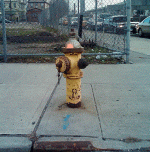- Joined
- May 6, 2010
- Messages
- 16,238
324 used to respond with SAT*4 to 10-75s in the old Jamaica Water Supply area thru out South Queens due to the old JWS Yellow Hydrants some which only had one 2 1/2 inch outlet on a six inch main........ in 275s area there were actually some Drafting Pits setup by the JWS ....the City has since upgraded the Hydrants / Mains after the DEP took over the JWS.......the JWS was a private corporation that ran a very efficient operation & actually had roving patrols that drove thru the streets surveying & testing their Hydrants....all Units in DV*13 would forward their Hydrant Repair tickets to DV*13 who would forward them to 275 & once each week we would bring all he Tickets to the JWS office near our FH & they would address them forthwith ......years ago they also had a system where if there was a job in the JWS area they could on a request from the IC thru the QNS Dispatcher actually raise the pressure in the mains (not to be confused with the old NYC Hi Pressure Hydrant System ) .......weekly Multi Unit Drills with 275...303...126 & BN*50 took place in an enclosed area of the York College maintenance area...there was an old time JWS Hydrant nearby that we hooked up to for Drill Evolutions.....one day when we were dropping off the Repair Tickets at the JWS office I asked them ( no report or anything just verbal to the person behind the counter) if they could upgrade the Hydrant that we used at the Drill Location....the next weekend when we went to Drill there was new Hydrant installed.... JWS was a very efficient operation........ regarding the MUD site at York College it adjoined a very old Cemetery & from time to time looking thru the fence it was sad to see that grave robbers would excavate a small area in front of a headstone ( so old that the chiseling had almost worn off ) in search of jewelry that had been buried there for so long.
Last edited:


